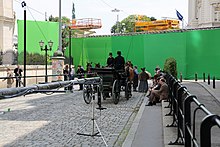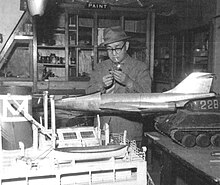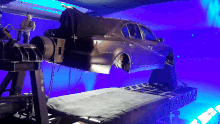Special effect
This article includes a list of generalreferences,butit lacks sufficient correspondinginline citations.(June 2017) |

Special effects(often abbreviated asF/Xor simplyFX) are illusions or visual tricks used in thetheatre,film,television,video game,amusement parkandsimulatorindustriesto simulate the imagined events in astoryorvirtual world.It used to be calledSFXbut this short form has also expanded to include“sound effects”as well.
Special effects are traditionally divided into the categories ofmechanical effectsandoptical effects.With the emergence of digital film-making a distinction between special effects andvisual effectshas grown, with the latter referring to digitalpost-productionand optical effects, while "special effects" refers to mechanical effects.
Mechanical effects (also calledpracticalorphysical effects) are usually accomplished during the live-action shooting. This includes the use of mechanizedprops,scenery,scale models,animatronics,pyrotechnicsand atmospheric effects: creating physical wind, rain, fog, snow, clouds, making a car appear to drive by itself and blowing up a building, etc. Mechanical effects are also often incorporated into set design and makeup. For example,prosthetic makeupcan be used to make an actor look like a non-human creature.
Optical effects (also called photographic effects) are the techniques in which images or film frames are created photographically, either "in-camera" usingmultiple exposure,mattesor theSchüfftan processor in post-production using anoptical printer.An optical effect might be used to place actors or sets against a different background.
Since the 1990s,computer-generated imagery(CGI) has come to the forefront of special effects technologies. It gives filmmakers greater control, and allows many effects to be accomplished more safely. As a result, many optical and mechanical effects techniques have been superseded by CGI.
Developmental history[edit]
Early development[edit]
In 1857,Oscar Rejlandercreated the world's first "special effects" image by combining different sections of 32 negatives into a single image, making amontagedcombination print.In 1895,Alfred Clarkcreated what is commonly accepted as the first-ever motion picture special effect. While filming a reenactment of the beheading ofMary, Queen of Scots,Clark instructed an actor to step up to the block in Mary's costume. As the executioner brought the axe above his head, Clark stopped the camera, had all of the actors freeze, and had the person playing Mary step off the set. He placed a Mary dummy in the actor's place, restarted filming, and allowed the executioner to bring the axe down, severing the dummy's head. Techniques like these would dominate the production of special effects for a century.[1]
It wasn't only the first use of trickery in cinema, it was also the first type of photographic trickery that was only possible in a motion picture, and referred to as the "stop trick".Georges Méliès,an early motion picture pioneer, accidentally discovered the same "stop trick." According to Méliès, his camera jammed while filming a street scene in Paris. When he screened the film, he found that the "stop trick" had caused a truck to turn into a hearse, pedestrians to change direction, and men to turn into women. Méliès, the stage manager at the Theatre Robert-Houdin, was inspired to develop a series of more than 500 short films between 1896 and 1914, in the process developing or inventing such techniques asmultiple exposures,time-lapse photography,dissolves,and hand painted color. Because of his ability to seemingly manipulate and transform reality with thecinematograph,the prolific Méliès is sometimes referred to as the "Cinemagician." His most famous film,Le Voyage dans la lune(1902), a whimsical parody ofJules Verne'sFrom the Earth to the Moon,featured a combination of live action andanimation,and also incorporated extensiveminiatureandmatte paintingwork.
From 1910 to 1920, the main innovations in special effects were the improvements on the matte shot byNorman Dawn.With the original matte shot, pieces of cardboard were placed to block the exposure of the film, which would be exposed later. Dawn combined this technique with the "glass shot." Rather than using cardboard to block certain areas of the film exposure, Dawn simply painted certain areas black to prevent any light from exposing the film. From the partially exposed film, a single frame is then projected onto an easel, where the matte is then drawn. By creating the matte from an image directly from the film, it became incredibly easy to paint an image with proper respect to scale and perspective (the main flaw of the glass shot). Dawn's technique became the textbook for matte shots due to the natural images it created.[2]
During the 1920s and 1930s, special effects techniques were improved and refined by the motion picture industry. Many techniques—such as theSchüfftan process—were modifications of illusions from the theater (such aspepper's ghost) and still photography (such as double exposure andmattecompositing).Rear projectionwas a refinement of the use of painted backgrounds in the theater, substituting moving pictures to create moving backgrounds. Lifecasting of faces was imported from traditional maskmaking. Along with makeup advances, fantastic masks could be created which fit the actor perfectly. As material science advanced, horror film maskmaking followed closely.

Many studios established in-house "special effects" departments, which were responsible for nearly all optical and mechanical aspects of motion-picture trickery. Also, the challenge of simulating spectacle in motion encouraged the development of the use of miniatures.Animation,creating the illusion of motion, was accomplished with drawings (most notably byWinsor McCayinGertie the Dinosaur) and with three-dimensional models (most notably byWillis O'BrieninThe Lost WorldandKing Kong). Naval battles could be depicted with models in studio. Tanks and airplanes could be flown (and crashed) without risk of life and limb. Most impressively, miniatures andmatte paintingscould be used to depict worlds that never existed.Fritz Lang's filmMetropoliswas an early special effects spectacular, with innovative use of miniatures, matte paintings, the Schüfftan process, and complex compositing.
An important innovation in special-effects photography was the development of theoptical printer.Essentially, an optical printer is a projector aiming into a camera lens, and it was developed to make copies of films for distribution. UntilLinwood G. Dunnrefined the design and use of the optical printer, effects shots were accomplished asin-camera effects.Dunn demonstrating that it could be used to combine images in novel ways and create new illusions. One early showcase for Dunn wasOrson Welles'Citizen Kane,where such locations asXanadu(and some ofGregg Toland's famous 'deep focus' shots) were essentially created by Dunn's optical printer.
Color era[edit]

The development of color photography required greater refinement of effects techniques. Color enabled the development of suchtravelling mattetechniques asbluescreenand thesodium vapour process.Many films became landmarks in special-effects accomplishments:Forbidden Planetused matte paintings, animation, and miniature work to create spectacular alien environments. InThe Ten Commandments,Paramount'sJohn P. Fulton,A.S.C., multiplied the crowds of extras in the Exodus scenes with careful compositing, depicted the massive constructions of Rameses with models, and split theRed Seain a still-impressive combination of travelling mattes and water tanks.Ray Harryhausenextended the art of stop-motion animation with his special techniques of compositing to create spectacular fantasy adventures such asJason and the Argonauts(whose climax, a sword battle with seven animated skeletons, is considered a landmark in special effects).
The science fiction boom[edit]
During the 1950s and 1960s numerous new special effects were developed which would dramatically increase the level of realism achievable inscience fiction films.Sci-fi special effects milestones in the 1950s included theGodzillafilms,The Day the Earth Stood Still(featuringKlaatu), and3-D films.[3]

Thetokusatsugenre ofJapanese science fictionfilm and television, which includes thekaijusub-genre ofmonster films,rose to prominence in the 1950s. The special-effects directorEiji Tsuburayaand the directorIshirō Hondabecame the driving forces behind theoriginalGodzilla(1954). Taking inspiration fromKing Kong(1933), Tsuburaya formulated many of the techniques that would become staples of thetokusatsugenre, such as so-calledsuitmation—the use of a human actor in a costume to play a giant monster—combined with the use of miniatures and scaled-down city sets.Godzillachanged the landscape ofJapanese cinema,science fiction and fantasy,[4]and kickstarted thekaijugenre in Japan called the "Monster Boom", which remained extremely popular for several decades, with characters such as the aforementionedGodzilla,GameraandKing Ghidorahleading the market. Tokusatsu films, notablyWarning from Space(1956), sparkedStanley Kubrick's interest in science fiction films; according to his biographerJohn Baxter,despite their "clumsy model sequences, the films were often well-photographed in colour... and their dismal dialogue was delivered in well-designed and well-lit sets."[5]
In 1968, Stanley Kubrick assembled his own effects team (Douglas Trumbull,Tom Howard,Con Pederson and Wally Veevers) rather than use an in-house effects unit for2001: A Space Odyssey.In this film, the spaceship miniatures were highly detailed and carefully photographed for a realisticdepth of field.The shots of spaceships were combined through hand-drawnrotoscopingand careful motion-control work, ensuring that the elements were precisely combined in the camera—a surprising throwback to the silent era, but with spectacular results. Backgrounds of the African vistas in the "Dawn of Man" sequence were combined with soundstage photography via the then-newfront projectiontechnique. Scenes set in zero-gravity environments were staged with hidden wires, mirror shots, and large-scale rotating sets. The finale, a voyage through hallucinogenic scenery, was created by Douglas Trumbull using a new technique termedslit-scan.
The 1970s provided two profound changes in the special effects trade. The first was economic: during the industry's recession in the late 1960s and early 1970s, many studios closed down their in-house effects houses. Technicians became freelancers or founded their own effects companies, sometimes specializing on particular techniques (opticals, animation, etc.).
The second was precipitated by the blockbuster success of two science-fiction and fantasy films in 1977.George Lucas'sStar Warsushered in an era of science-fiction films with expensive and impressive special effects. Effects supervisorJohn Dykstra,A.S.C. and crew developed many improvements in existing effects technology. They created a computer-controlled camera rig called the "Dykstraflex" that allowed precise repetition of camera motion, greatly facilitating travelling-matte compositing. Degradation of film images during compositing was minimized by other innovations: the Dykstraflex usedVistaVisioncameras that photographedwidescreenimages horizontally along stock, using far more of the film per frame, and thinner-emulsion filmstocks were used in the compositing process. The effects crew assembled by Lucas was dubbedIndustrial Light & Magic,and since 1977 has spearheaded many effects innovations.
That same year,Steven Spielberg's filmClose Encounters of the Third Kindboasted a finale with impressive special effects by2001veteran Douglas Trumbull. In addition to developing his own motion-control system, Trumbull also developed techniques for creating intentional "lens flare"(the shapes created by light reflecting in camera lenses) to provide the film's undefinable shapes of flying saucers.
The success of these films, and others since, has prompted massive studio investment in effects-heavy science-fiction films. This has fueled the establishment of many independent effects houses, a tremendous degree of refinement of existing techniques, and the development of new techniques such ascomputer-generated imagery(CGI). It has also encouraged within the industry a greater distinction between special effects andvisual effects;the latter is used to characterize post-production and optical work, while "special effects" refers more often to on-set and mechanical effects.
Introduction of computer-generated imagery (CGI)[edit]
The use ofcomputer animationin film dates back to the early 1980s, with the filmsTron(1982)[3]andGolgo 13: The Professional(1983).[6]Since the 1990s, a profound innovation in special effects has been the development ofcomputer-generated imagery(CGI), which has changed nearly every aspect of motion picture special effects. Digital compositing allows far more control and creative freedom than optical compositing, and does not degrade the image as with analog (optical) processes. Digital imagery has enabled technicians to create detailed models, matte "paintings," and even fully realized characters with the malleability of computer software.
Arguably the biggest and most "spectacular" use of CGI is in the creation of photo-realistic images of science-fiction/fantasy characters, settings and objects. Images can be created in a computer using the techniques of animated cartoons and model animation.The Last Starfighter(1984) used computer generated spaceships instead of physicalscale models.In 1993, stop-motion animators working on the realistic dinosaurs ofSteven Spielberg'sJurassic Parkwere retrained in the use of computer input devices. By 1995, films such asToy Storyunderscored the fact that the distinction between live-action films and animated films was no longer clear. Other landmark examples include a character made up of broken pieces of a stained-glass window inYoung Sherlock Holmes,a shape-shifting character inWillow,a tentacle formed from water inThe Abyss,the T-1000 Terminator inTerminator 2: Judgment Day,hordes and armies of robots and fantastic creatures in theStar Wars (prequel)andThe Lord of the Ringstrilogies, and the planet, Pandora, inAvatar.
Planning and use[edit]
Although most visual effects work is completed duringpost-production,it must be carefully planned and choreographed inpre-productionandproduction.Avisual effects supervisoris usually involved with the production from an early stage to work closely with the Director and all related personnel to achieve the desired effects.
Practical effects also require significant pre-planning and co-ordination with performers and production teams. The live nature of the effects can result in situations where resetting due to an error, mistake, or safety concern incurs significant expense, or is impossible due to the destructive nature of the effect.
Live special effects[edit]
Live special effects are effects that are used in front of a live audience, such as in theatre, sporting generation genre, concerts and corporate shows. Types of effects that are commonly used include: flying effects,laser lighting,theatrical smoke and fog,CO2effects,andpyrotechnics.Other atmospheric effects can include flame,confetti,bubbles, and snow.[7]
One notable example of live special effects in theatre production is in theBregenz Festivalwith its use of a large, intricate stage that moves to supplement what's being acted on stage.[8]
Mechanical effects[edit]

Mechanical effectsencompass the use ofmechanical engineeringto a greater degree. Cars being flipped and hauled over buildings are usually an effect built on specializedrigsandgimbals.Usually a team of engineers or freelance film companies provide these effects toproducers.Camera workers, stunt artists or doubles, directors and engineers collaborate to produce the proper effect as the action is recorded against a green screen. It is then edited and reviewed before final release to the public.
Visual special effects techniques[edit]

- Bullet hit squibs
- Bullet time
- Computer-generated imagery(often usingShaders)
- Digital compositing
- Dolly zoom
- In-camera effects
- Match moving
- Matte (filmmaking)andMatte painting
- Video matting
- Miniature effects
- Morphing
- Motion control photography
- Optical effects
- Optical printing
- Practical effects
- Prosthetic makeupeffects
- Rotoscoping
- Reverse motion
- Stop motion
- Go motion
- Schüfftan process
- Splash of color[9]
- Traveling matte
- Virtual cinematography
- Wire removal
Noted special effects companies[edit]
- Adobe Systems Incorporated(San Jose, USA)
- Animal Logic(Sydney, Australia; Venice, USA)
- Bird Studios(London, UK)
- BUF Compagnie(Paris, France)
- CA Scanline(Munich, Germany)
- Cinema Research Corporation,defunct (Hollywood, USA)
- Cinesite(London, UK; Hollywood, USA)
- Creature Effects, Inc.(Los Angeles, USA)
- Digital Domain(Playa Vista, USA)
- Double Negative (VFX)(London, UK)
- DreamWorks(Los Angeles, USA)
- Flash Film Works(Los Angeles, USA)
- Fireark Special Effects(Brisbane, Australia)
- Framestore(London, UK)
- Hydraulx(Santa Monica, USA)
- Image Engine(Vancouver, Canada)
- Industrial Light & Magic(San Francisco, USA), founded byGeorge Lucas
- Intelligent Creatures(Toronto, Canada)
- Jim Henson's Creature Shop,(Los Angeles; Hollywood; Camden Town, London)
- Legacy Effects,(Los Angeles, USA)
- Look Effects,(Culver City, USA)
- M5 Industries(San Francisco, USA) home ofMythBusters
- Mac Guff(Los Angeles, USA; Paris, France)
- Machine Shop (London, UK)
- Makuta VFX(Universal City, USA; Hyderabad, India)
- Matte World Digital(Novato, USA)
- Method Studios(Los Angeles, USA; New York, USA; Vancouver, Canada)
- The Mill(London, UK; New York, USA; Los Angeles, USA)
- Modus FX(Montreal, Canada)
- Moving Picture Company(Soho, London, UK)
- Pixomondo(Frankfurt; Munich; Stuttgart; Los Angeles; Beijing; Toronto; Baton Rouge, LA)
- Rainmaker Digital Effects(Vancouver, Canada)
- Rhythm and Hues Studios(Los Angeles, USA)
- Rise FX(Berlin, Germany)
- Rising Sun Pictures(Adelaide, Australia)
- Rodeo FX(Montreal; Munich; Los Angeles)
- Snowmasters(Lexington, AL, USA)
- Sony Pictures Imageworks(Culver City, USA)
- Strictly FX,live special effects company
- Surreal World(Melbourne, Australia)
- Super FX, Special Effects Company (Italy)
- Tippett Studio(Berkeley, USA)
- Tsuburaya Productions(Hachimanyama, Setagaya, Tokyo)
- Vision Crew Unlimited,defunct (Los Angeles, USA)
- Wētā FX,(Wellington, New Zealand)
- Zoic Studios(Culver City, USA)
- ZFX Inca flying effects company (Louisville, USA; Utrecht, the Netherlands)
Noted special effects directors[edit]
- Eiji Tsuburaya,the "Father ofTokusatsu"
- Tom Howard
- John P. Fulton
- Douglas Trumbull
- Ken Pepiot
- Stan Winston
- John Dykstra
- Koichi Kawakita
- Teruyoshi Nakano
- Yonesaburo Tsukiji
- Yoshiyuki Kuroda
- Yoshihiro Nishimura
- Akira Watanabe
Notes[edit]
- ^Rickitt, 10.
- ^Baker, 101-4
- ^ab"The Making of Tron".Video Games Player.Vol. 1, no. 1. Carnegie Publications. September 1982. pp. 50–5.
- ^Millennial Monsters: Japanese Toys and the Global Imagination,pp. 47–8.ISBN0-520-24565-2
- ^Baxter, John (1997).Stanley Kubrick: A Biography.New York: Basic Books. p.200.ISBN0786704853.
- ^Beck, Jerry (2005).The Animated Movie Guide.Chicago Review Press.p. 216.ISBN1569762228.
- ^Danielle S. Hammelef (2015).Explosive Scenes: Fireballs, Furious Storms, and More Live Special Effects.Capstone. p. 18.ISBN978-1-4914-2003-4.
- ^"Bregenz Festival's most spectacular water stages".CinemaLive.Retrieved6 March2022.
- ^Peshin, Akash (4 December 2017)."How Are Black And White Films Colorized?".Science ABC.Wattcon Technologies Private Limited.Retrieved14 October2023.
References[edit]
- Cinefexmagazine
- American Cinematographermagazine
- Richard Rickitt:Special Effects: The History and Technique,Billboard Books;2nd edition, 2007;ISBN0-8230-8408-6
- Movie Magic: The History of Special Effects in the CinemabyJohn Brosnan(1974)
- Techniques of Special Effects CinematographybyRaymond Fielding(For many years, the standard technical reference. Current edition 1985)
- Special Effects: Titanic and BeyondThe online companion site to the NOVA documentary (See especially thetimelineandglossary)
- T. Porter and T. Duff, "Compositing Digital Images", Proceedings of SIGGRAPH '84, 18 (1984).
- The Art and Science of Digital Compositing (ISBN0-12-133960-2)
- McClean, Shilo T. (2007).Digital Storytelling: The Narrative Power of Visual Effects in Film.The MIT Press.ISBN978-0-262-13465-1.
- Mark Cotta Vaz;Craig Barron:The Invisible Art: The Legends of Movie Matte Painting,Chronicle Books, 2004;ISBN0-8118-4515-X
- Larry Nile Baker, A History of Special Effects Cinematography in the United States, 1895–1914,Larry Nile Baker, 1969.
External links[edit]
- Video (03:04) – Evolution of Special Effects since 1878.
- How to Add Special Effects to Your Videos.
- Chinese Film Classics: Special effects in early Chinese cinema:clips and discussion of special effects in Chinese films from before 1949, on scholarly website chinesefilmclassics.org
